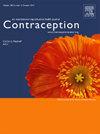Future reproductive outcomes and contraceptive access in the first year postpartum after non-receipt of postpartum permanent contraception
IF 2.3
2区 医学
Q1 OBSTETRICS & GYNECOLOGY
引用次数: 0
Abstract
Objective
Our objective was to compare pregnancy, contraceptive uptake, and health care utilization in the 365 days following delivery, between those who requested and did not receive permanent contraception and those who requested other types of postpartum contraception.
Study design
This was a retrospective cohort study of 1412 patients among 5688 delivering in 2018 at one health system. Our primary outcome was pregnancy within 365 days postpartum and we compared 207 individuals who requested and did not receive permanent contraception, with 956 who requested other types of contraception. Secondary outcomes included care utilization and contraceptive uptake in the year postpartum.
Results
Individuals with unfulfilled permanent contraception requests had similar incidence of pregnancy by 365 days postpartum as those planning other types of contraception (9.2% vs 8.6%, p = 0.79), a difference which persisted after adjusting for parity and insurance type. Those with unfulfilled requests returned for postpartum care somewhat less frequently (58.5% vs 66.1%, p = 0.04) but were more likely to use more effective contraception (35.3% vs 17.6%, p < 0.001).
Conclusions
We report future pregnancy incidence among those with unfulfilled permanent contraception similar to patients not requesting permanent contraception. Patients had relatively high rates of postpartum visits and use of highly-effective contraception, demonstrating the value of these services.
Implications
Policies facilitating access to contraception and postpartum follow up could help reduce the risk of future pregnancy, even among those unable to access preferred contraception at the time of delivery.
未接受产后永久避孕后第一年的未来生殖结果和避孕药具获取情况。
目的:我们的目的是比较在分娩后365天内,要求和没有接受永久性避孕和要求其他类型产后避孕的妇女的妊娠、避孕措施的摄取和保健利用情况。研究设计:这是一项回顾性队列研究,对2018年在一个卫生系统分娩的5688名患者中的1412名患者进行了研究。我们的主要结局是在产后365天内怀孕,我们比较了207名要求和没有接受永久性避孕措施的人,以及956名要求其他类型避孕措施的人。次要结局包括产后一年的护理利用和避孕药具摄取。结果:未满足永久避孕要求的个体与计划其他避孕方式的个体在产后365天的怀孕发生率相似(9.2% vs 8.6%, p =0.79),在调整胎次和保险类型后,差异仍然存在。未满足要求的患者返回产后护理的频率略低(58.5% vs 66.1%, p=0.04),但更有可能使用更有效的避孕措施(35.3% vs 17.6%)。结论:我们报告了未满足永久避孕要求的患者与未要求永久避孕的患者的未来妊娠发生率相似。患者有相对较高的产后访问率和使用高效避孕措施,表明这些服务的价值。意义:促进获得避孕药具和产后随访的政策可以帮助降低未来怀孕的风险,即使在分娩时无法获得首选避孕药具的妇女也是如此。
本文章由计算机程序翻译,如有差异,请以英文原文为准。
求助全文
约1分钟内获得全文
求助全文
来源期刊

Contraception
医学-妇产科学
CiteScore
4.70
自引率
17.20%
发文量
211
审稿时长
69 days
期刊介绍:
Contraception has an open access mirror journal Contraception: X, sharing the same aims and scope, editorial team, submission system and rigorous peer review.
The journal Contraception wishes to advance reproductive health through the rapid publication of the best and most interesting new scholarship regarding contraception and related fields such as abortion. The journal welcomes manuscripts from investigators working in the laboratory, clinical and social sciences, as well as public health and health professions education.
 求助内容:
求助内容: 应助结果提醒方式:
应助结果提醒方式:


